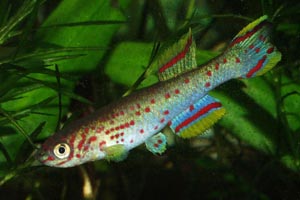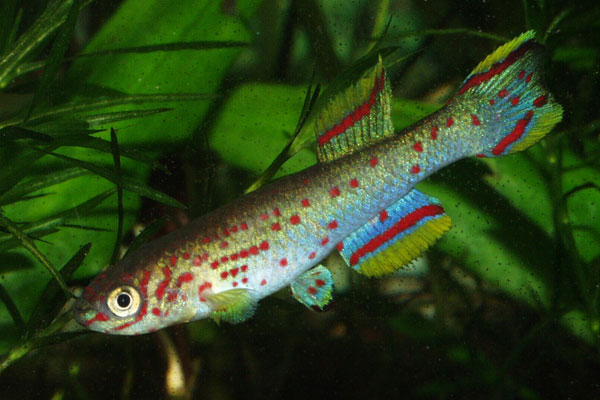

Species Profile | Images | Breeding Report | Similar Species

(Other members of the genus Fundulopanchax)
ADULT SIZE: 7 cm
WATER CONDITIONS: Not critical
TEMPERATURE RANGE: 23-28 C
FOOD: Feed Fundulopanchax nigerianus live and dried foods
DISTRIBUTION: This species comes from Nigeria
AQUARIUM CARE: These are some of the most attractive and hardy killifish available, and are regulaly seen in aquarium shops. Males can be aggressive at times, and a group of 1 male to 2-3 females can help in this. Keeping with other fundulopanchax or aphyosemion is not advisable as they will cross-breed, and smaller males will often be bullied. This species was moved to the genus Fundulopanchax from Aphyosemion, though the common name 'steel-blue Aphyosemion' is still widely used.
BREEDING: Breeding is easily achieved in a well planted tank (use najas in particular) and fry will grow up with their parents. Spawning mops allow greater productivity, though also more work!
Have you bred Fundulopanchax nigerianus? Why not fill in a breeding questionaire?, or examine existing Fundulopanchax nigerianus breeding reports
Other members of the genus Fundulopanchax
Other killifish species
Other species from Nigeria

Fundulopanchax gardneri nigerianus Makurdi
BREEDING: Breeding is easily achieved in a well planted tank (use najas in particular) and fry will grow up with their parents. Spawning mops allow greater productivity, though also more work!
Have you bred Fundulopanchax nigerianus? Why not fill in a breeding questionaire?
This page summarises breeding reports provided by visitors to this site, along with some statistical analysis. Please feel free to contribute - whatever your experience!
| |||||||||
|
| ||||||||
|
| ||||||||
|
| ||||||||
Remember, each record represents only one persons experience; if you had different results, or used different methods, please share your experiences
| Water conditions: Neutral | Water temperature: 24-27oC |
| Disposition: Active, but not aggresive | Community tank?: Only with species of similar size |
| Spawning Method: Long term (fry appear with adults) | Breeding problems: none |
| Sex ratio: | Breeding difficulty: Average |
| Sucess: Very sucessful | Years Experience: 10 |
| Other Comments: I breed this fish by filling (and I mean filling) a tank with free-floating plants, hornwort, najas etc. If fed well this tank will be full of fry and young fish of various sizes a few weeks later. Feeding newly hatched artemia on a regular basis will increase fry numbers. | |
| Date this record created: 6th January 2008 | Breeding date: 2007 |
| Breeder: | Location: |